The initial police account of George Floyd’s death called it a “medical incident.”
But the revelation when bystander video showed a Minneapolis officer had kneeled on Floyd’s neck for nearly nine minutes sparked a wave of protests and breathed energy into activist movements for racial justice that singularly captured the attention of the nation at scale seldom seen.
Our data offers a uniquely broad view of how news of Floyd’s death and the subsequent protests has greatly outscaled nearly every other individual topic in recent memory in terms of readership.
Here’s a comparison to give you a sense of the magnitude of reader interest. Joe Biden won a hotly contested race to become the Democratic nominee for US president over the course of 2020. He has been in the news in some way, shape or form every day for the entire year.
Still, when you add up all the page views on articles about Biden from US news consumers over all of 2020, the total is not even half of the amount of page views on articles about George Floyd in June alone.
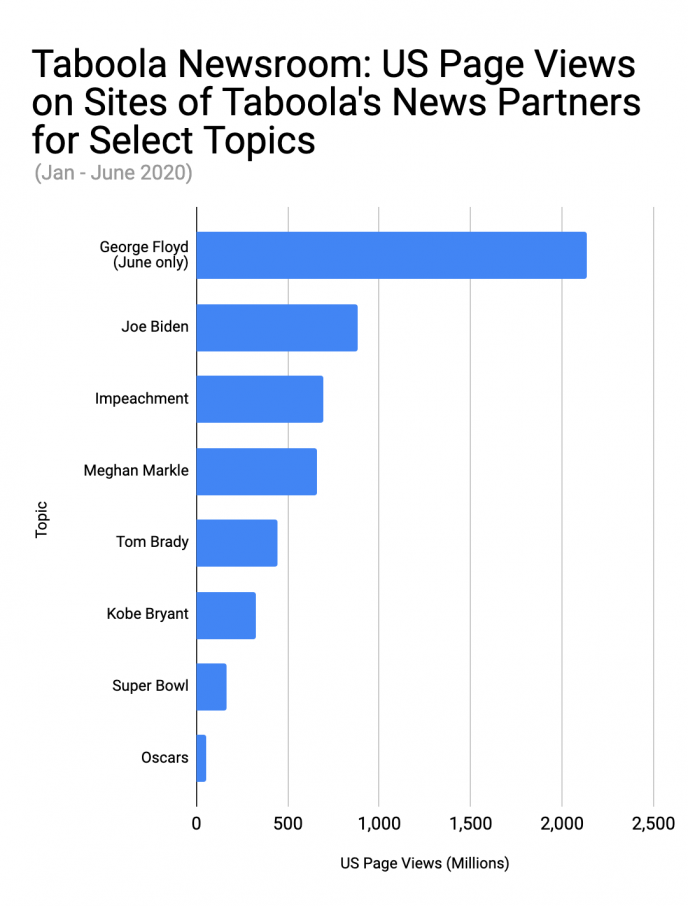
(Data: Taboola Newsroom‘s Topic Insights)
When we look at the highest readership topics for June only, we can see that the audience for articles about George Floyd was significantly larger than even articles about Trump and coronavirus. Nearly one of every three news article views we saw in June were on stories about Floyd.
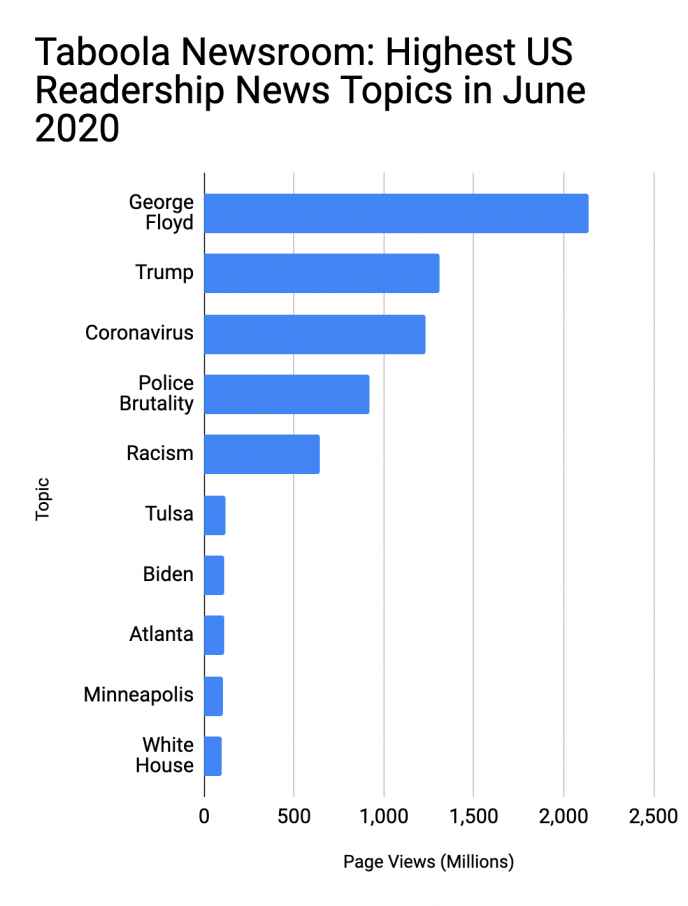
(Data: Taboola Newsroom‘s Topic Insights)
Topics related to the George Floyd killing also appear on the top 10, including police brutality and racism.
The figures in the charts above come from Taboola Newsroom’s Topic Insights, which uses natural language processing AI to categorize and measure the readership of the biggest news topics across our network of news publisher partners.
We work with over 1,000 news sites in the US from local publishers to large national outlets, so the sample size is quite large and robust.
Our Collective Gaze
It’s important, when looking at data like this, to always remember this isn’t a popularity contest.
Loss of life should never be trivialized. Behind these sterile numbers, there’s a giant and complex pool of grief, anger, frustration, sadness, outrage, pain, and other intense emotions profoundly impacting us as individuals and the dynamics of the communities we’re a part of.
The level of news reader interest in Floyd’s death and subsequent protests in comparison to other massively consequential events, however, begins to reveal the degree to which this has struck a collective nerve at a time when our collective societal nervous system was already primed.
“What you’re seeing is a hyperfocus on one story,” says Ethan Zuckerman, who studies media coverage and audience attention as director of MIT’s Center for Civic Media. “Weirdly and intensely, that focus swung away from coronavirus, which continued to kill thousands of people, to racism, which frankly also kills tens of thousands of people.”
In the months before Floyd’s death, coronavirus impacted every aspect of life. When cities and states went into lockdown, people turned to the news to figure out what was happening at increased rates and with a singular focus.
Before coronavirus, the highest readership monthly topics we’d see (almost always Trump) would get a volume of page views in the 300 million to 500 million range.
In March, we saw nearly 4.5 billion page views about coronavirus—about 10x more than a typical highest monthly readership topic.
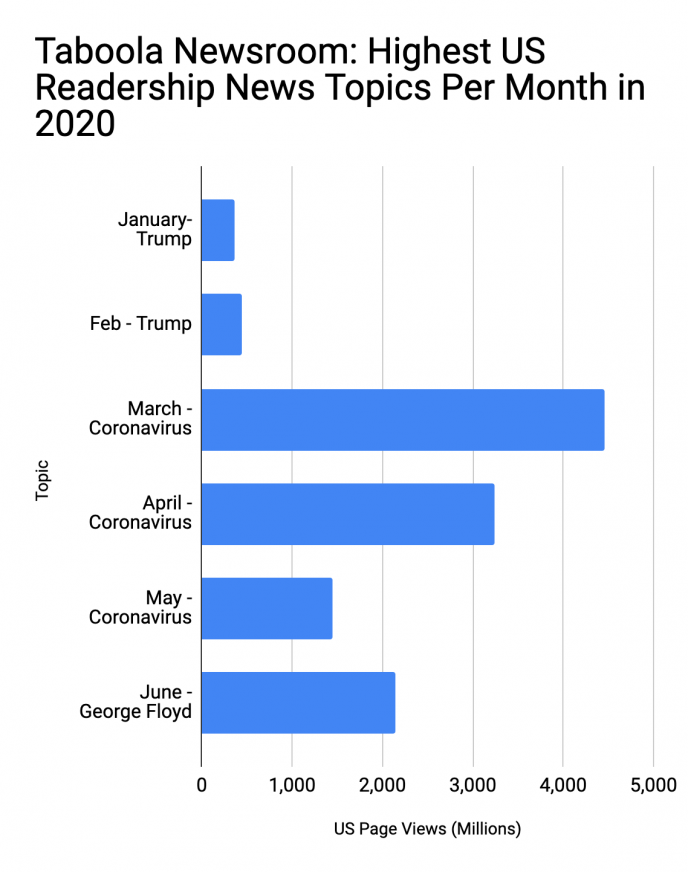 (Data: Taboola Newsroom‘s Topic Insights)
(Data: Taboola Newsroom‘s Topic Insights)
Just as the coronavirus was becoming more familiar and readership levels dipped down in May, news of George Floyd’s killing broke and our collective attention intensely refocused for weeks — again at a level essentially unseen before the coronavirus.
Black Lives Matter
A recent Pew public opinion poll found a solid majority of Americans—nearly 70%—support the Black Lives Matter movement, which emerged in response to the killing of Trayvon Martin in 2012. This wasn’t always the case.
In 2016, Pew found only 43% of people expressed support for Black Lives Matter.
The Washington Post recently reported on “How the Black Lives Matter movement went mainstream,” which captures activists’ observations of how public sentiment has changed.
“It’s now something where the Mitt Romneys of the world can join in, and that was something unimaginable back in 2014. That is the result of six years of hard work by people who are in the movement and have put forward so many discussions that really changed people’s hearts and minds,” Justin Hansford, an activist in Ferguson, Mo., told The Post.
A 2019 study titled “Whose deaths matter?” by MIT’s Zuckerman and his colleagues from Cornell University and IE University in Spain sheds light on how the activists’ “hard work” Hansford mentions above translated into a shift in public opinion.
The study looks at the news media coverage following the killings of 343 unarmed Black men and women from 2013 to 2016. They found the 2014 killing of Michael Brown in Ferguson was a crucial turning point.
At the time, Brown’s killing and the subsequent protests received an unprecedented amount of national media attention.
Compared to the killings before Brown, the ones that came after were more likely to receive any news coverage and sometimes a significant amount, as measured by the number of articles mentioning the person’s name.
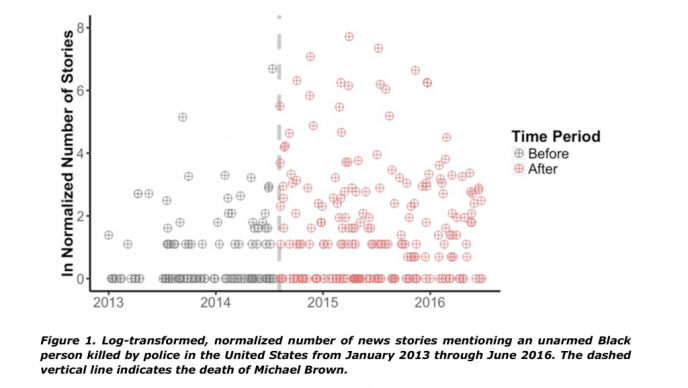
(Credit: MIT Media Lab/Center for Civic Media)
In addition, after Brown’s killing, subsequent news stories about Black victims were far more likely to mention the name of another victim. This indicates that the news media began presenting these killings not as isolated incidents, but as part of a troubling trend.
“Although our research focuses on correlation, not causation, we speculate, based on our findings, that activist efforts such as Black Lives Matter help frame individual deaths as part of a larger pattern, contributing to the construction of a media agenda that addresses larger issues of race, bias, and policing,” Zuckerman and his colleagues wrote in their paper.
In offering analysis of Taboola’s readership data, Zuckerman also helped us revisit his past research to see how coverage of George Floyd’s death compares.
Using Media Cloud, a tool built by MIT and Harvard that scans news websites, we were able to see in 2014 there were two weeks when more than 4% of the articles published by a sample of top US news sources mentioned “Mike Brown” or “Michael Brown.”
The first spike came in August in the days after Brown’s death when media attention turned to the subsequent protests. The second spike happened in November when a grand jury decided not to indict the officer who shot Brown.
This level of coverage puts the amount of media resources dedicated to Brown’s death at a similar level to Kobe Bryant’s death earlier this year. Sudden and unexpected tragedies like Bryant’s death inspire a massive amount of coverage from the media. Basically every news outlet in the country will write about it, probably multiple articles over a period of weeks or months.
Comparatively, nearly 10% of all news articles from the same top news sources mentioned George Floyd in the week after his death, and more than 30% mention him the following week as a shockwave of protests radiated out from Minneapolis reaching all across the US and the entire world.
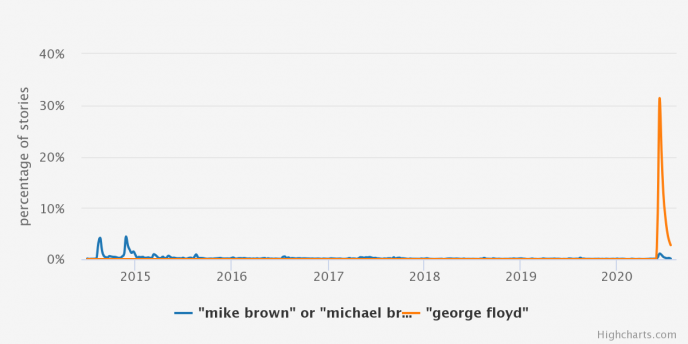
(Data via Media Cloud)
Zuckerman says he believes in both cases, it was particularly heinous aspects of the killings—Brown’s body was left in the street for hours and Floyd’s death was captured on video—that caused the initial wave of attention, but the mobilization of protesters after was what sustained it.
“There’s a finite number of stories you can write about the killing of an individual,” he says. “Once you get a protest movement around it, then you have a whole other group of stories you can write.”
These two pieces of the formula—ubiquitous news coverage, as measured by MIT’s Media Cloud, and unprecedented audience readership, as measured by Taboola’s Topic Insights—allow us to begin to quantify the widespread attention that has ushered into the mainstream conversations that may have seemed radical just months ago such as completely rethinking the role of policing in towns and cities.
What Happens Next?
This massive amount of interest can’t and won’t last forever.
After Furgeson, Zuckerman found that media coverage of the killings of unarmed Black men and women declined over time. Eventually the 2016 election of Donald Trump changed the entire media attention ecosystem and specifically impacted how racial justice issues were covered.
Already, we’re seeing readership of stories about George Floyd decline from the unprecedented highs of June. We still have a pandemic raging that’s going to require intense focus from the news media for the foreseeable future.
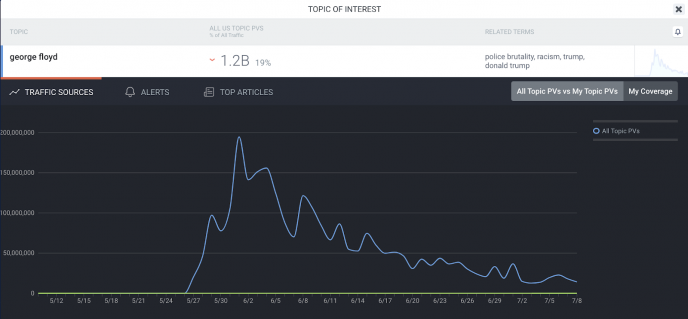
This is not necessarily a negative thing. It’s just a reality that happens with every news topic, including coronavirus.
At some point, believe it or not, we’ll even stop regularly reading about Donald Trump.
What’s meaningful for topics associated with activist causes such as Black Lives Matter is that the time in the public consciousness has a lasting impact.
Ferguson made Black Lives Matter a household name, even if it didn’t engender a majority of people supporting the cause.
The aftermath of the George Floyd killing brought that majority support and renewed conversations about the role of policing and the ongoing effects of systemic racism. It may lead to slashed police budgets and other reforms before the wave of attention again goes dormant.
At the same time as society is being impacted by the cycles of media attention, the news media itself will have lasting takeaways.
One example is the self-reflection by the news industry on getting the right tone and offering the appropriate context when covering protests.
Researchers have described what they call “the protest paradigm,” which essentially is the news media’s tendency to find isolated acts of violence and vandalism to focus on amid huge protest movements composed almost entirely of participants who are neither violent nor destructive.
Zuckerman says he believes one takeaway for the media will be increased scrutiny of police narratives of events. This may seem obvious, but resource-starved local news outlets are often between a rock and a hard place because they need to maintain relationships with local police departments to effectively report on crime.
Surveys have found that younger people are tuning into the news at increased rates to read about George Floyd and Black Lives Matter, so this also potentially represents an opportunity for news orgs to build relationships with their next generation of loyal readers.
It’s far too soon to draw any conclusions about how the legacy of the extremely consequential events of early 2020 will be defined with regard to their impact on anti-racism movements.
We’re sitting at the intersection of a local-turned-global protest movement within the context of a global viral pandemic within the backdrop of a presidency that was already capturing news reader interest at unprecedented levels. There are overlapping and interacting forces between all of these elements, and it’s going to take time to untangle it all.
The data on news coverage and consumption do seem to confirm what our eyes are telling us: this is a historic moment that will have a lasting impact.
Doing research or reporting on interest in news topics? Feel free to DM @franberkman on Twitter if you think our readership data could help support your project.